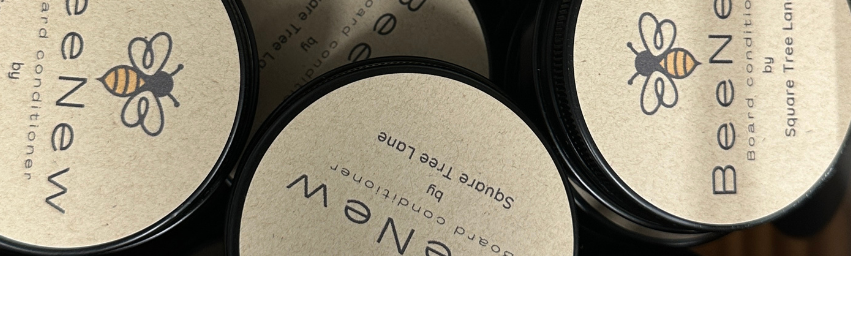
November 24, 2024
Board Maintenance
By Michele Parkinson

The instructions below will walk you through the conditioning process for all of our hand crafted wood boards. To learn how to clean, sanitize, deodorize, dos & don'ts, & much more, please read on.

YOUR BOARD IS ALREADY CONDITIONED WHEN IT ARRIVES
Your Square Tree Lane board goes through a two stage conditioning process before being shipped to you. Stage one is a dip of food grade mineral oil. After that soaks in, we condition it with BeeNew™, (our own special blend of food safe conditioner). To maintain your board, we recommend re-conditioning it whenever needed with a food safe board conditioner that has an unlimited shelf life. There are many conditioners to choose from but we believe BeeNew™ is the best
for a number of reasons.
- A little goes a long way & it isn't as messy as some conditioners, making the job much easier without spilling or wasting product. Speaking from my own personal experience, when something doesn't seem like such a difficult task, I am less likely to put it off.
- BeeNew™ only contains two ingredients and they are both FDA approved for wood surfaces that are intended for food. Both ingredients have a never-ending shelf life so your board will always look and smell great.
-
Because we want you to love your board now and long into the future, we include a 2 oz container of BeeNew™ with every board purchase.

HOW OFTEN SHOULD YOU CONDITION YOUR BOARD?
The process for conditioning is always the same, but the frequency required will vary depending on the board type and how often it's used. Cutting boards require more attention. They are used for things that require sanitizing and more sanitizing will make it necessary to condition more often. When cutting raw meat or chicken, it is important to sanitize before using it again. Charcuterie boards are usually exposed to cooked food and all that is necessary is a mild detergent. That said, after you have cleaned and given your board adequate dry time, it's a good time to assess whether it needs conditioning. If it looks or feels dry, you can bring it back to life by using BeeNew™ conditioner or any other conditioner that has been deemed food safe and offers unlimited shelf life.
The bottom line: Boards are pretty forgiving so don't stress if you didn't get it conditioned right away. The overall maintenance is what matters. Watching your board transform from dull and dry to rich and full of depth will likely be encouragement enough for you to break out the conditioner more often.
HOW TO SANITIZE YOUR BOARD
There are many opinions about the best way to sanitize your board but we know of two ways that are backed by science.
The Bleach Method
- Clean the board: Start by washing the board with warm water and mild dish soap to remove any food residue.
- Prepare the bleach solution: Mix 2 teaspoons of unscented liquid chlorine bleach per gallon of cold water.
- Apply the solution: Use a sponge or cloth to apply bleach solution to board. Let set 2 minutes before rinsing.
- Rinse thoroughly: Rinse the board thoroughly with clean water to remove all traces of bleach.
- Dry: Dry the board completely with a clean towel and let air dry before applying any conditioner if you are planning to do so.
By following these steps, you can effectively sanitize your cutting board and kill any bacteria or viruses that may be present.
The Vinegar Method (our preferred method)
To clean your cutting board with vinegar, you can use a simple solution of equal parts white vinegar and water. Here's a step-by-step guide:
- Clean the Board: Start by washing the board with warm water and mild dish soap to remove any food residue.
- Prepare the Vinegar Solution: Mix equal parts white vinegar and water in a spray bottle or bowl.
- Apply the Solution: Spray or wipe the vinegar solution onto the entire surface of the cutting board.
- Scrub: Use a clean cloth or sponge to scrub the board, paying special attention to any cuts or grooves.
- Rinse: Rinse the board thoroughly with clean water.
- Dry: Dry the board completely with a towel and let air dry before using or applying conditioner..
Additional Tips:
- Frequency: Clean your cutting board more often if it is used frequently for raw meat or poultry.
- Sanitizing: For extra sanitation, you can use a stronger vinegar solution (e.g., 1 part vinegar to 2 parts water).
-
Drying: Make sure to dry your cutting board completely to prevent mold and bacteria growth.
-
Avoid Soaking: Avoid soaking your cutting board in water for extended periods, as this can damage the wood.
By following these steps, you can effectively clean and sanitize your cutting board, keeping it safe for food preparation.
LEMON JUICE & SALT BOARD DEODERIZER
Sprinkle 1/3 cup (more or less depending on how big or small your board is), & spread evenly. Let SALT sit on board for 10 minutes & then massage a half a lemon over entire board, letting lemon juice soak entire board for a few moments. Rinse thoroughly & dry well (see drying instructions in lemon juice/baking soda instructions above).

BIG NO NOS

-
Never submerge cutting board in water. A quick dunk to remove excess food is okay but soaking can cause warping.
-
NEVER PUT YOUR CUTTING BOARD IN THE DISHWASHER. The excessive heat, constant exposure to water and harsh detergents will cause the board to dry out, warp and/or crack.
-
Avoid using harsh or concentrated cleaners on your board.
-
Never use cooking oil on your cutting board. Over time, it will become rancid and smell. Don't do it. Not even coconut oil. According the the FDA, you should only use beeswax, food grade mineral oil, or a blend of both.


Leave a comment
Also in THE WOOD FILES
Wood species: the good, the bad, & the ugly
By Michele Parkinson October 24, 2024
Continue reading
WHEN LIFE GIVES YOU LEMONS, CLEAN YOUR CUTTING BOARD.
By Michele Parkinson August 29, 2024
Continue reading
EAT, SLEEP, BUILD, AND REPEAT (WHAT TO CONSIDER BEFORE BUYING A CUTTING BOARD)
By Michele Parkinson August 06, 2024
Wood species matters. Some woods are actually toxic and should never be used to cut meat or veggies.
Continue reading